Abstract
The effects of sucralfate and ranitidine on the gastrointestinal manifestations of phenylbutazone (PBZ) toxicity in horse foals were determined by complete blood count, serum chemistry profile, and gross and histological necropsy examinations. Twenty-eight, three to four month old Belgian-cross foals were randomly assigned to one of four groups. Phenylbutazone was administered at a dosage of 10 mg/kg of bodyweight (BW) per day, intravenously (IV), in equally divided doses to three of the groups. In addition to PBZ, ranitidine was administered at 2 mg/kg BW, IV, twice daily, to one group of seven foals (PBZ/ranitidine group), and sucralfate was administered at 4 g, orally, twice daily to another group of seven foals (PBZ/sucralfate group). A fourth group received normal saline IV and corn syrup orally, twice daily, as placebos (control group). Treatments were administered for ten days. Clinical signs included oral ulceration (in all PBZ-treated foals) and diarrhea (5/7 and 2/7 foals from the PBZ and PBZ/ranitidine groups, respectively). A reduction in total protein and albumin was greatest in the PBZ group and least in the PBZ/ranitidine and PBZ/sucralfate groups when compared to the control group. The PBZ group lost weight during the treatment period. At necropsy, the PBZ group had the greatest area of oral ulceration compared to the other treatment groups. All foals treated with PBZ had gastric ulcers; however, the PBZ group had the most severe gastric epithelial necrosis compared to the other three treatment groups. Duodenal villous atrophy, epithelial necrosis and mucosal inflammation, and a reduction in epithelial mitotic figures were seen in all PBZ-treated foals.(ABSTRACT TRUNCATED AT 250 WORDS)
Full text
PDF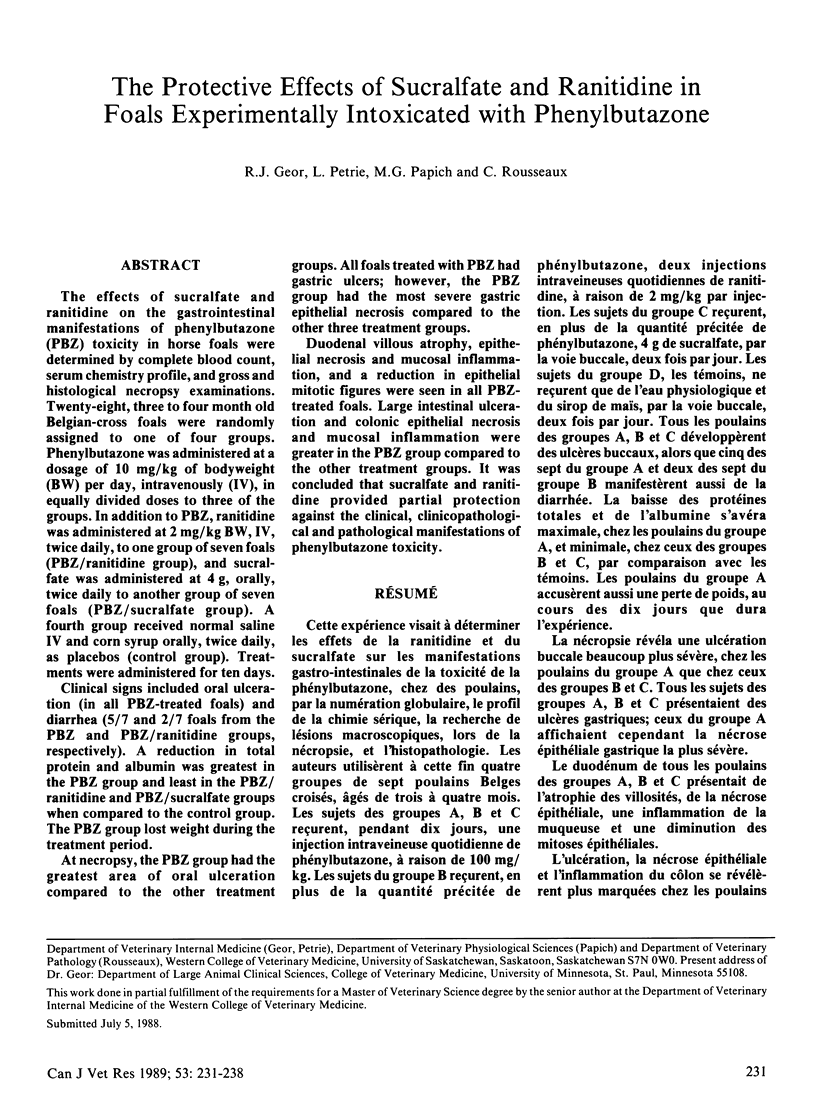
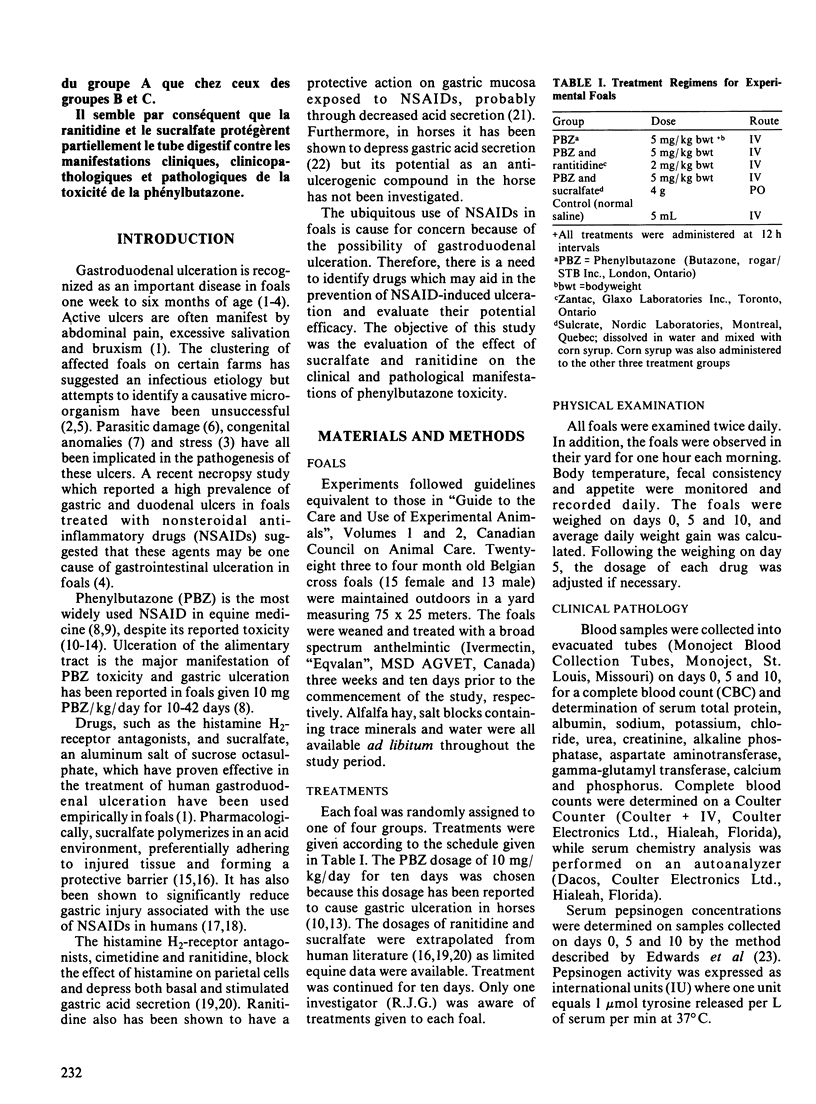
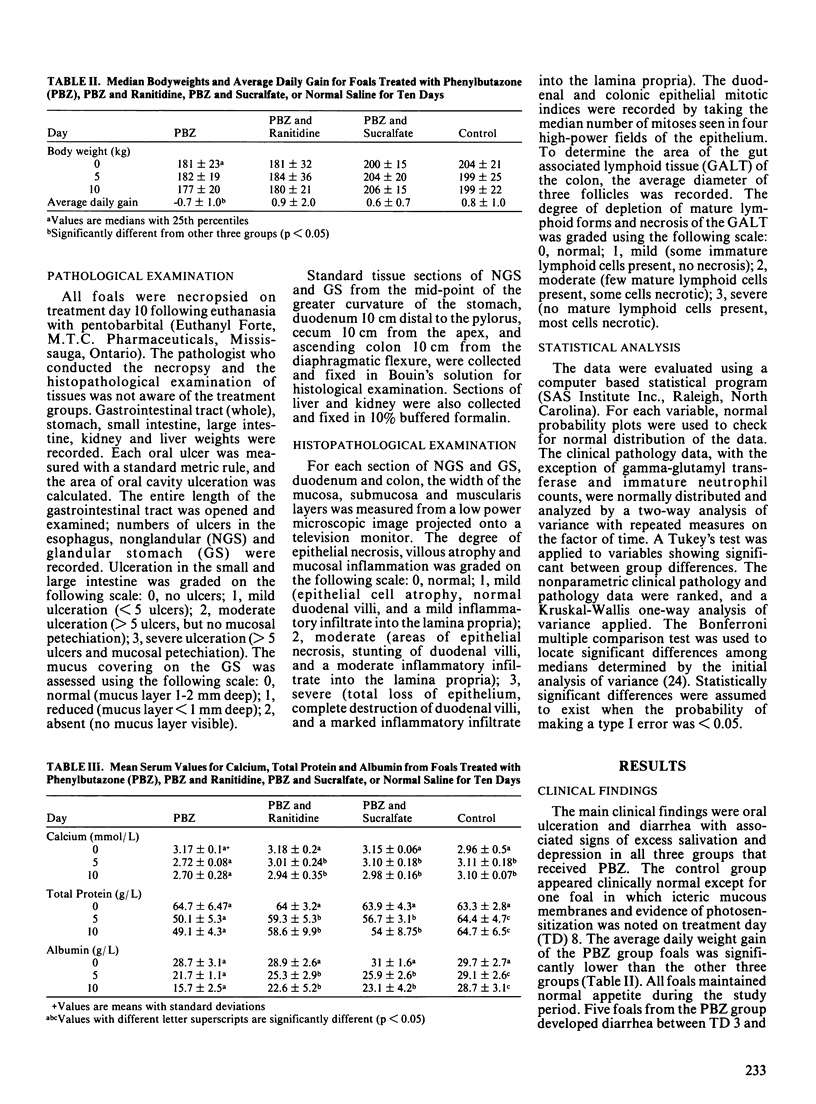
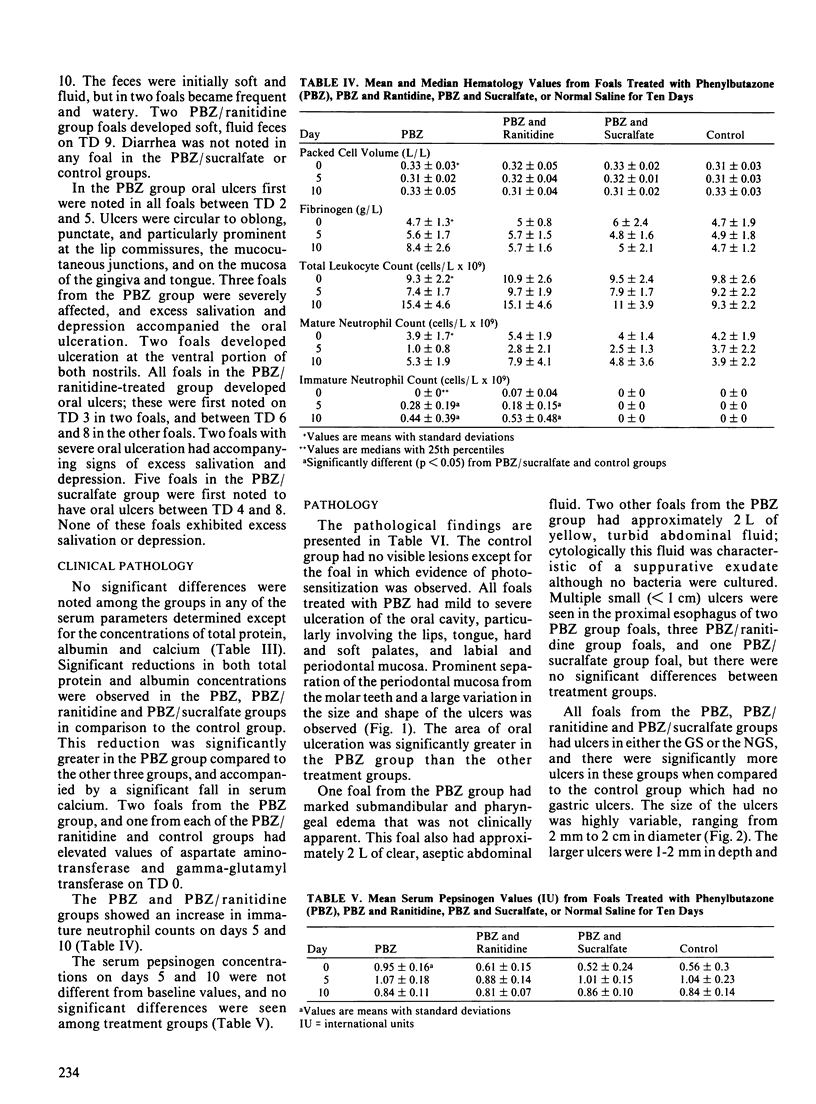
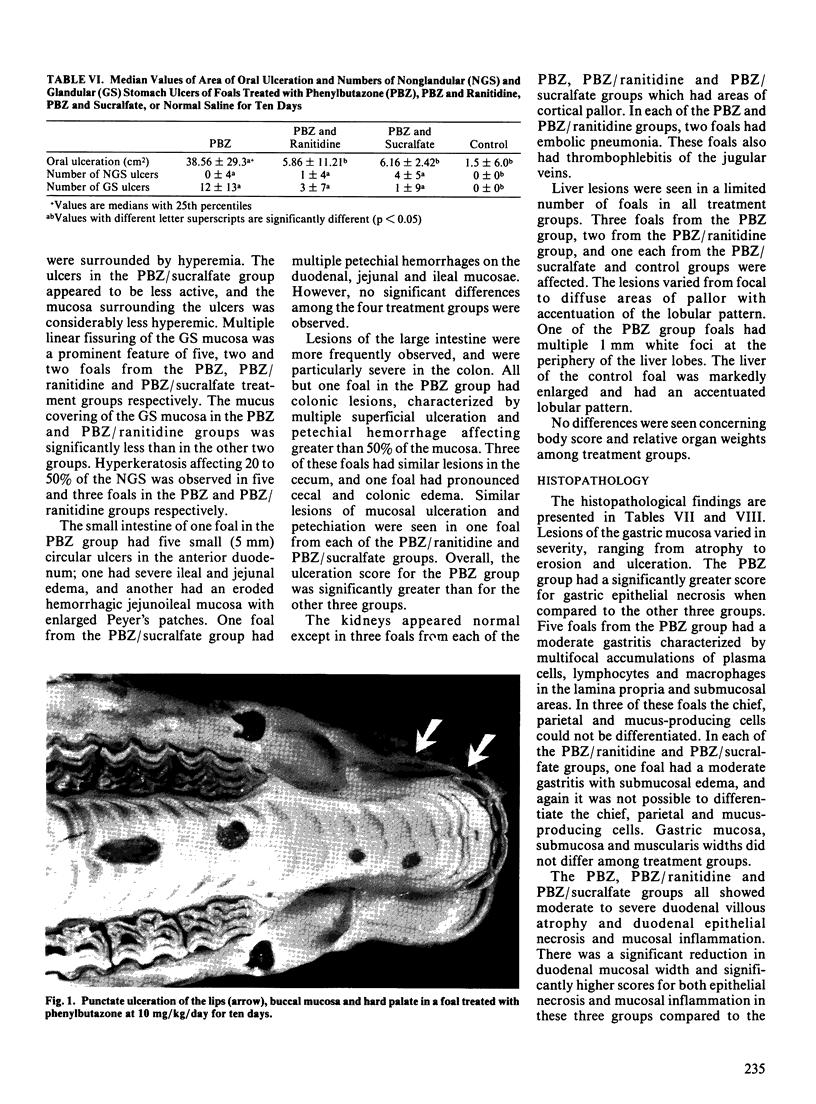
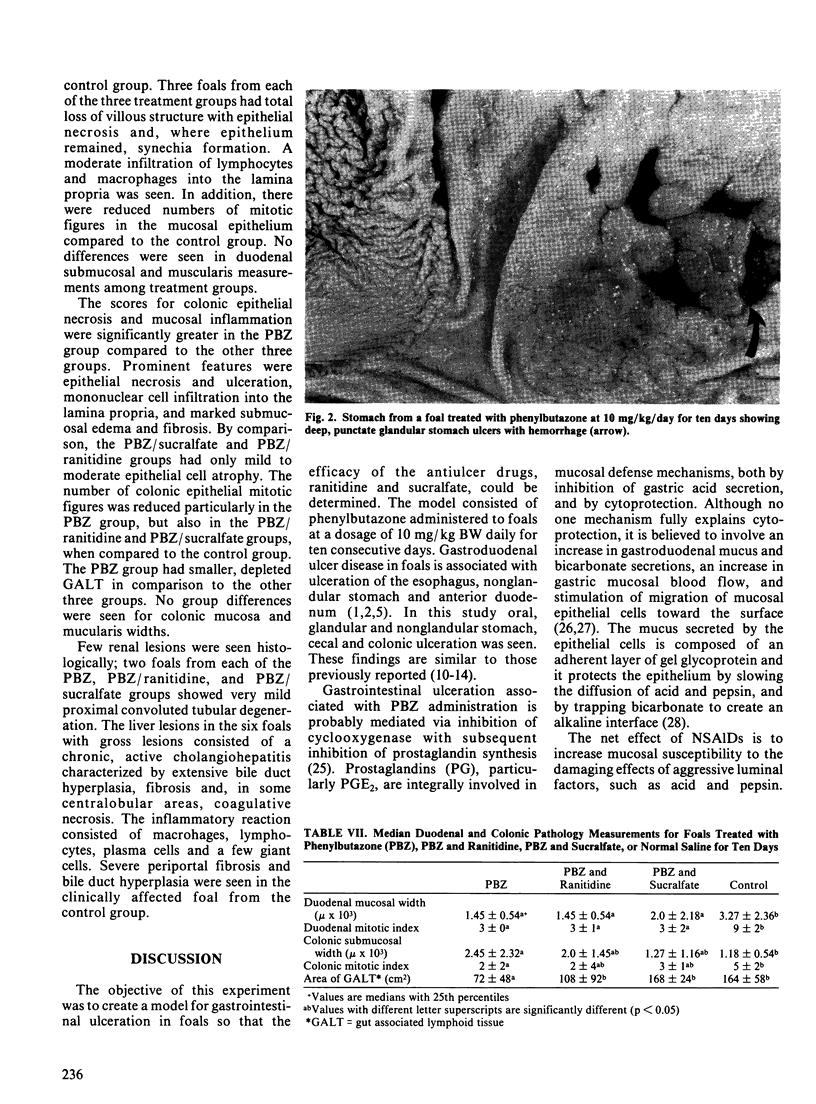
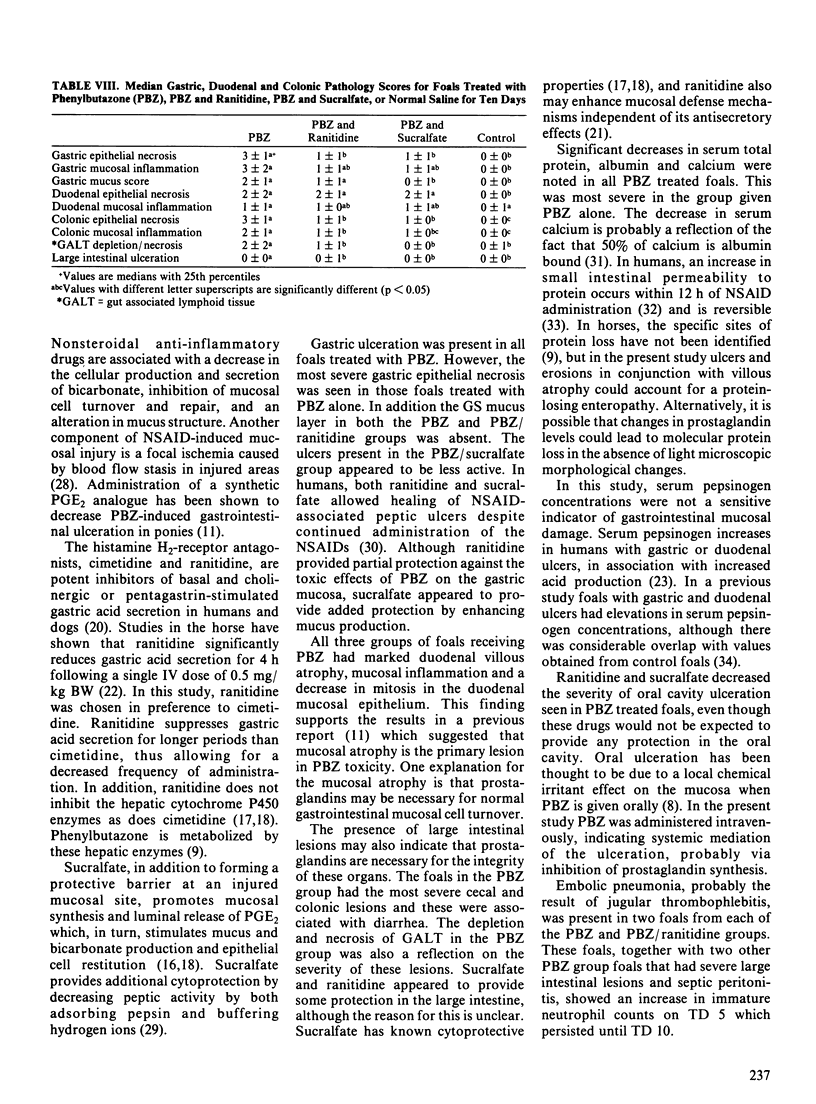
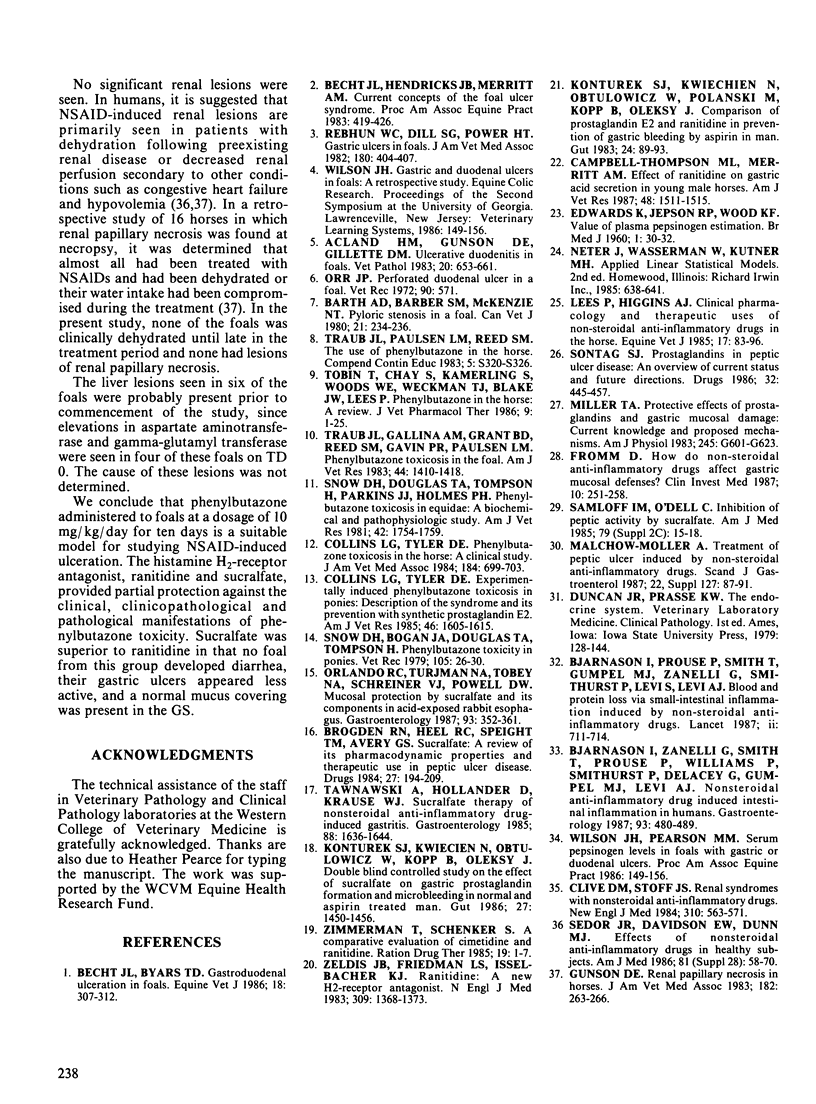
Images in this article
Selected References
These references are in PubMed. This may not be the complete list of references from this article.
- Acland H. M., Gunson D. E., Gillette D. M. Ulcerative duodenitis in foals. Vet Pathol. 1983 Nov;20(6):653–661. doi: 10.1177/030098588302000601. [DOI] [PubMed] [Google Scholar]
- Barth A. D., Barber S. M., McKenzie N. T. Pyloric stenosis in a foal. Can Vet J. 1980 Aug;21(8):234–236. [PMC free article] [PubMed] [Google Scholar]
- Becht J. L., Byars T. D. Gastroduodenal ulceration in foals. Equine Vet J. 1986 Jul;18(4):307–312. doi: 10.1111/j.2042-3306.1986.tb03638.x. [DOI] [PubMed] [Google Scholar]
- Bjarnason I., Zanelli G., Prouse P., Smethurst P., Smith T., Levi S., Gumpel M. J., Levi A. J. Blood and protein loss via small-intestinal inflammation induced by non-steroidal anti-inflammatory drugs. Lancet. 1987 Sep 26;2(8561):711–714. doi: 10.1016/s0140-6736(87)91075-0. [DOI] [PubMed] [Google Scholar]
- Bjarnason I., Zanelli G., Smith T., Prouse P., Williams P., Smethurst P., Delacey G., Gumpel M. J., Levi A. J. Nonsteroidal antiinflammatory drug-induced intestinal inflammation in humans. Gastroenterology. 1987 Sep;93(3):480–489. doi: 10.1016/0016-5085(87)90909-7. [DOI] [PubMed] [Google Scholar]
- Brogden R. N., Heel R. C., Speight T. M., Avery G. S. Sucralfate. A review of its pharmacodynamic properties and therapeutic use in peptic ulcer disease. Drugs. 1984 Mar;27(3):194–209. doi: 10.2165/00003495-198427030-00002. [DOI] [PubMed] [Google Scholar]
- Campbell-Thompson M. L., Merritt A. M. Effect of ranitidine on gastric acid secretion in young male horses. Am J Vet Res. 1987 Oct;48(10):1511–1515. [PubMed] [Google Scholar]
- Clive D. M., Stoff J. S. Renal syndromes associated with nonsteroidal antiinflammatory drugs. N Engl J Med. 1984 Mar 1;310(9):563–572. doi: 10.1056/NEJM198403013100905. [DOI] [PubMed] [Google Scholar]
- Collins L. G., Tyler D. E. Experimentally induced phenylbutazone toxicosis in ponies: description of the syndrome and its prevention with synthetic prostaglandin E2. Am J Vet Res. 1985 Aug;46(8):1605–1615. [PubMed] [Google Scholar]
- Collins L. G., Tyler D. E. Phenylbutazone toxicosis in the horse: a clinical study. J Am Vet Med Assoc. 1984 Mar 15;184(6):699–703. [PubMed] [Google Scholar]
- EDWARDS K., JEPSON R. P., WOOD K. F. Value of plasma pepsinogen estimation. Br Med J. 1960 Jan 2;1(5165):30–32. doi: 10.1136/bmj.1.5165.30. [DOI] [PMC free article] [PubMed] [Google Scholar]
- Fromm D. How do non-steroidal anti-inflammatory drugs affect gastric mucosal defenses? Clin Invest Med. 1987 May;10(3):251–258. [PubMed] [Google Scholar]
- Gunson D. E. Renal papillary necrosis in horses. J Am Vet Med Assoc. 1983 Feb 1;182(3):263–266. [PubMed] [Google Scholar]
- Konturek S. J., Kwiecień N., Obtułowicz W., Kopp B., Oleksy J. Double blind controlled study on the effect of sucralfate on gastric prostaglandin formation and microbleeding in normal and aspirin treated man. Gut. 1986 Dec;27(12):1450–1456. doi: 10.1136/gut.27.12.1450. [DOI] [PMC free article] [PubMed] [Google Scholar]
- Konturek S. J., Kwiecień N., Obtułowicz W., Polański M., Kopp B., Oleksy J. Comparison of prostaglandin E2 and ranitidine in prevention of gastric bleeding by aspirin in man. Gut. 1983 Feb;24(2):89–93. doi: 10.1136/gut.24.2.89. [DOI] [PMC free article] [PubMed] [Google Scholar]
- Lees P., Higgins A. J. Clinical pharmacology and therapeutic uses of non-steroidal anti-inflammatory drugs in the horse. Equine Vet J. 1985 Mar;17(2):83–96. doi: 10.1111/j.2042-3306.1985.tb02056.x. [DOI] [PubMed] [Google Scholar]
- Malchow-Møller A. Treatment of peptic ulcer induced by non-steroidal anti-inflammatory drugs. Scand J Gastroenterol Suppl. 1987;127:87–91. doi: 10.3109/00365528709090957. [DOI] [PubMed] [Google Scholar]
- Miller T. A. Protective effects of prostaglandins against gastric mucosal damage: current knowledge and proposed mechanisms. Am J Physiol. 1983 Nov;245(5 Pt 1):G601–G623. doi: 10.1152/ajpgi.1983.245.5.G601. [DOI] [PubMed] [Google Scholar]
- Orlando R. C., Turjman N. A., Tobey N. A., Schreiner V. J., Powell D. W. Mucosal protection by sucralfate and its components in acid-exposed rabbit esophagus. Gastroenterology. 1987 Aug;93(2):352–361. doi: 10.1016/0016-5085(87)91026-2. [DOI] [PubMed] [Google Scholar]
- Orr J. P. Perforated duodenal ulcer in a foal. Vet Rec. 1972 May 13;90(20):571–571. doi: 10.1136/vr.90.20.571. [DOI] [PubMed] [Google Scholar]
- Rebhun W. C., Dill S. G., Power H. T. Gastric ulcers in foals. J Am Vet Med Assoc. 1982 Feb 15;180(4):404–407. [PubMed] [Google Scholar]
- Samloff I. M., O'Dell C. Inhibition of peptic activity by sucralfate. Am J Med. 1985 Aug 30;79(2C):15–18. doi: 10.1016/0002-9343(85)90566-2. [DOI] [PubMed] [Google Scholar]
- Sedor J. R., Davidson E. W., Dunn M. J. Effects of nonsteroidal anti-inflammatory drugs in healthy subjects. Am J Med. 1986 Aug 25;81(2B):58–70. doi: 10.1016/0002-9343(86)90908-3. [DOI] [PubMed] [Google Scholar]
- Snow D. H., Bogan J. A., Douglas T. A., Thompson H. Phenylbutazone toxicity in ponies. Vet Rec. 1979 Jul 14;105(2):26–30. doi: 10.1136/vr.105.2.26. [DOI] [PubMed] [Google Scholar]
- Snow D. H., Douglas T. A., Thompson H., Parkins J. J., Holmes P. H. Phenylbutazone toxicosis in equidae: a biochemical and pathophysiological study. Am J Vet Res. 1981 Oct;42(10):1754–1759. [PubMed] [Google Scholar]
- Sontag S. J. Prostaglandins in peptic ulcer disease. An overview of current status and future directions. Drugs. 1986 Nov;32(5):445–457. doi: 10.2165/00003495-198632050-00003. [DOI] [PubMed] [Google Scholar]
- Tobin T., Chay S., Kamerling S., Woods W. E., Weckman T. J., Blake J. W., Lees P. Phenylbutazone in the horse: a review. J Vet Pharmacol Ther. 1986 Mar;9(1):1–25. doi: 10.1111/j.1365-2885.1986.tb00008.x. [DOI] [PubMed] [Google Scholar]
- Traub J. L., Gallina A. M., Grant B. D., Reed S. M., Gavin P. R., Paulsen L. M. Phenylbutazone toxicosis in the foal. Am J Vet Res. 1983 Aug;44(8):1410–1418. [PubMed] [Google Scholar]
- Zeldis J. B., Friedman L. S., Isselbacher K. J. Ranitidine: a new H2-receptor antagonist. N Engl J Med. 1983 Dec 1;309(22):1368–1373. doi: 10.1056/NEJM198312013092206. [DOI] [PubMed] [Google Scholar]
- Zimmerman T. W., Schenker S. A comparative evaluation of cimetidine and ranitidine. Ration Drug Ther. 1985 Apr;19(4):1–7. [PubMed] [Google Scholar]




